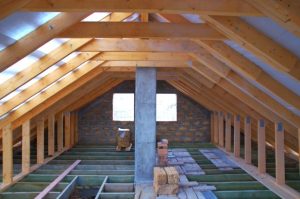Many homeowners eager to make more room within their homes look to the attic for additional storage space. We understand the thinking. Afterall, most attics are what most people would consider “dead” space. Homeowners look at the attic above the garage and see a space that can house seasonal decorations, clothing, and random clutter that accumulates around the house all year long. But attics serve a pretty important role in regulating your home’s interior climate, and not all attics are designed to support the weight of storing your family’s belongings.
In this article, we’ll discuss the purpose of an attic as well as some pitfalls of converting your attic into home storage. Can it be done? Yes. But should it? Read on to learn more.
The Purpose of an Attic

Many people are surprised to learn an attic serves a purpose. Attics are a natural creation of the sloped roofs we typically see in Northeast Ohio to shed rain and snow throughout the year.
The attic also serves a very important role in regulating the home’s interior climate. With a properly ventilated and insulated roof, your attic should hold in your home’s heat in the winter and shield your home from extreme heat in the summer. The climate control your attic provides prevents your roof from overheating in the summer and ice dams from forming in the winter, both of which significantly shorten the life of your roof. In addition to this, the framing of an attic supports the weight of your roof, distributing it down the load-bearing walls and all the way through the foundation.
Support of Trussed vs. Stick-Framed Attics
One of the most important design elements of your attic is its framing. Attics are either framed with rafters or built using trusses. Both are designed to support and distribute the weight of your home’s roof.
Stick-Framed Attic
 A “stick-framed” attic is built up using rafters, one “stick” at a time. Rafters vary in size but are heavier lumber than what is typically used in trusses. An attic framed with rafters is built on-site, using -2x or engineered lumber that extends from the roof peak (the ridge board) all the way down to the top plate of your home’s exterior wall. The rafters typically overhang the top plate to form the eaves of the house. A framed attic is installed one rafter at a time, with the ceiling joists (the attic’s floor) being installed before the rafters, which hold up the roof. A “stick-framed” attic provides an open space that has the potential to be used for storage or converted into living space.
A “stick-framed” attic is built up using rafters, one “stick” at a time. Rafters vary in size but are heavier lumber than what is typically used in trusses. An attic framed with rafters is built on-site, using -2x or engineered lumber that extends from the roof peak (the ridge board) all the way down to the top plate of your home’s exterior wall. The rafters typically overhang the top plate to form the eaves of the house. A framed attic is installed one rafter at a time, with the ceiling joists (the attic’s floor) being installed before the rafters, which hold up the roof. A “stick-framed” attic provides an open space that has the potential to be used for storage or converted into living space.
Trussed Attic
 Trusses work much the same way, but they are prefabricated and usually made from lighter wood. They arrive at your home’s building site as pre-assembled triangles of lumber joined together with truss plates. The attic space beneath a trussed roof has an extensive network of angled web framing that connects the top chords (similar to rafters, but much lighter) to the bottom chord, which creates the ceiling beneath the attic space. Attics made from trusses should not be used for storage. Not only does the web framing limit the amount of usable space, but the trusses are not engineered to support any substantial weight bearing directly down on them.
Trusses work much the same way, but they are prefabricated and usually made from lighter wood. They arrive at your home’s building site as pre-assembled triangles of lumber joined together with truss plates. The attic space beneath a trussed roof has an extensive network of angled web framing that connects the top chords (similar to rafters, but much lighter) to the bottom chord, which creates the ceiling beneath the attic space. Attics made from trusses should not be used for storage. Not only does the web framing limit the amount of usable space, but the trusses are not engineered to support any substantial weight bearing directly down on them.
Moisture & Temperature Levels in the Attic
 Determining whether your attic can support the weight of the items you intend to store is one major consideration when deciding whether you should convert it for storage space. But another big consideration must be whether the items you intend to store will withstand the moisture and temperature fluctuations they will be subjected to in the attic. A properly ventilated and well insulated attic is designed to match the attic temperature and humidity to the outdoors. In Northeast Ohio, temperatures and humidity levels vary drastically, often dipping below zero in the winter and screaming into the 90s (or higher) in the summer. A poorly ventilated attic allows heat to build up in the attic, which leads to extreme temperatures during the summer and high moisture—even water leaks—in the winter. Consider the impact these fluctuating temperatures and humidity levels will have on whatever you decide to store in the attic.
Determining whether your attic can support the weight of the items you intend to store is one major consideration when deciding whether you should convert it for storage space. But another big consideration must be whether the items you intend to store will withstand the moisture and temperature fluctuations they will be subjected to in the attic. A properly ventilated and well insulated attic is designed to match the attic temperature and humidity to the outdoors. In Northeast Ohio, temperatures and humidity levels vary drastically, often dipping below zero in the winter and screaming into the 90s (or higher) in the summer. A poorly ventilated attic allows heat to build up in the attic, which leads to extreme temperatures during the summer and high moisture—even water leaks—in the winter. Consider the impact these fluctuating temperatures and humidity levels will have on whatever you decide to store in the attic.
Bathroom Fans & Range Hoods Venting into the Attic
Another important thing to consider about moisture levels and the quality of air in your attic is that many bathroom fans and range hoods vent into the attic. Venting to the attic is not ideal, but it is often the only option. In a well-ventilated attic, the moisture from showers and cooking odors will vent quickly to the outside. But they still pass through the attic. When the attic is not properly ventilated, the moisture and odors hang around, collecting on whatever surfaces they find. Most of the items people put in storage—papers, photographs, decorations, and clothing—will hold on to these odors and moisture, potentially allowing mold a place to grow.
The Attic & Your Home’s Structure Integrity

Trusses and rafters are designed to hold up the weight of your home’s roof, distributing it evenly and safely throughout the load bearing walls on through down to the foundation. While most attic joists will be strong enough to allow you to move around for an inspection and may even provide storage for empty boxes or lightweight items, they will not typically be strong enough to support the weight of multiple people, heavier objects, or furniture. If you overload the joists in your attic, you risk having your roof collapse.
The strength of your attic floor depends on the attic construction (rafters vs. trusses) and the size and span of the joists. It’s important to mention here too that the joists will support this weight, but the space between them will not. Be careful where you step! Joists that are made from 2x4s will be strong enough to support empty boxes, and those made from 2x6s will be able to support boxes filled with relatively light items. Joists that are 2×8 are typically the largest and will be able to support substantially more weight. Before you begin hauling items into your attic, we recommend having a licensed roofing contractor assess the storage potential your attic offers.
Call Aapex Construction & Restoration to Assess Your Attic Storage Potential!
If you’re planning on using your attic as storage or converting it into living space, always consult with a licensed roofing contractor who can assess your attic’s potential to safely support the added weight. Aapex Construction & Restoration has more than 20 years of experience in the construction industry and has the expertise and knowledge to be able to gauge how much additional weight your attic will be able to support. We are licensed, bonded, and insured and make it our mission to exceed your expectations on quality and customer care. Contact us today for a consultation on your attic’s storage potential.
Related Articles
The Importance of Proper Roof Ventilation
The Causes of Roof Ice Dams and How to Prevent Them



Very Interesting, excellent work and many thanks for sharing such an excellent blog.
Hi! I’ve been looking for a company that can handle a trussed roof to attic conversion in Columbus ohio and you are one of the closest I’ve found! I’d love one of your experts to evaluate our home and see if there is potential.
Please call us Heather 330-421-4161 today.